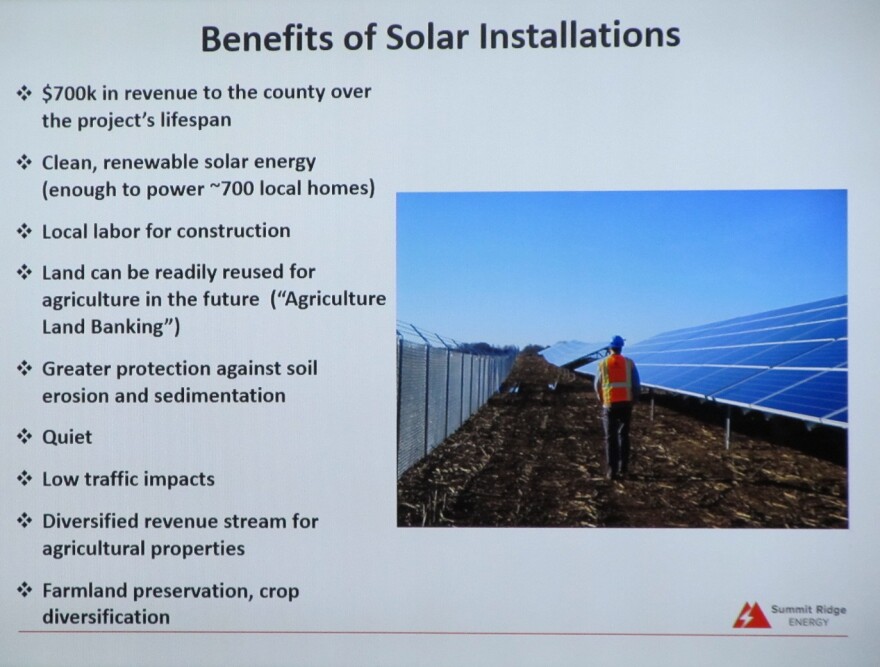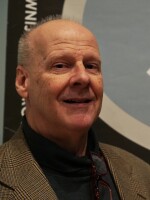Solar power has been used here and there in Illinois for a long time. But now the state is going for it in a big way.
In the 19th Century, scientists discovered that you could generate electricity directly from sunlight when you arrange certain elements in a particular way. In the 1950s, scientists at Bell Labs took an element they were using to develop the first transistors – silicon – to create the photovoltaic, or PV, cells that we know today.
This fact is noted in a 1954 episode of the television show, The Bell Telephone Science Hour, called "Our Mr. Sun."
https://www.youtube.com/watch?v=JBwZ6UT0mMI&list=PL_sjhEFSOGfBcUPywiy5l9jze20wxr7HQ
In the segment, a curious Everyman remarks to an animated 'Mr. Sun' about the device: "Well, the science boys have come up with a cake that makes electricity out of your sunlight."
A second character representing a scientific authority figure, replies: "You mean the solar battery. Well it's hardly more than a solar cookie."
Everyman: "But Doc, that's big news!"
It was inefficient and expensive, and practical only for specialized uses like powering space satellites. Fast forward 60 years, and things are quite different.
Look around, and you begin to see solar arrays everywhere powering construction signs, homes or businesses -- even those little garden lights you can buy at Menard's or Home Depot. And there are larger arrays, not just in the desert Southwest, but in Illinois. The growth, however, has been piecemeal up to now.
With the Future Energy Jobs Act of 2016, Illinois charted a course to boost renewable energy, particularly solar, in a big way.
It's all being managed by the Illinois Power Agency (IPA), led by Anthony Star. It was established to manage electricity markets, including renewables, and still does. But the new law gives it a mandate to create the framework for a new energy market in Illinois.
"So there's really two paths forward on renewable energy coming out of the Future Energy Jobs Act," Star said. "For large-scale renewable, such as wind farms or solar that's located on brownfields, we use the competitive procurement model, where we basically put out a request for proposals and people come with specific projects and bid on price."
It sounds straightforward, but Star says there's more to it than a simple cash transaction.
"Now the thing to note is: What is it that people are bidding [for]? And what it is, is something called a renewable energy credit, and the bidding is for the price of one of these," he said.

Renewable energy credits were developed by the renewables industry as a way to separate the environmental benefits from the electricity itself. They have value, and can be sold or traded separate from the electricity.
It's not a novel approach. And there are already such projects on the ground or working their way through the zoning process.
There's also a small program called "Solar for All," that aims to help low-income residents who want to go solar. But the biggest chunk of the money allocated for renewables under the Act is going to something called community solar. For that the IPA developed the adjustable block program. Here the agency sets a price, and people or businesses apply to get into it.
But what is community solar? Advocates say it's built around what they call "solar gardens." As the name suggests, these are smaller arrays of solar panels, covering five to 15 acres, that generate up to two Megawatts of electricity – by one estimate, enough to power 350 homes. Many proposals seek adjacent pairs of arrays, so a project might double that amount.

A good analogy might be community supported agriculture. People who want fresh local produce, but don't have the time or space to grow it, subscribe to a CSA farm. In return, they get boxes of in-season fruits and vegetables from the farmer they're helping to support. People who want to draw energy from solar, but can't generate it, can subscribe to draw a set amount of electricity from an array in their utility's service area. You don't get a box of electricity on your doorstep, but you will get a credit on your electric bill for the amount of power you've subscribed for. And if the company that runs the solar garden beats the price your utility charges, your overall costs will end up lower.
Jim Chilsen is with the Citizens Utility Board 0r CUB which advocates for utility consumers. He's enthusiastic about the potential of community solar.
Community solar has the potential to democratize solar power. -Jim Chilsen, Citizens Utility Board
"Well, what CUB has found, is that policies that protect the planet are also great for the pocketbook," he said. "And that's where we come in. I mean, we're a consumer group that is concerned with lowering electric bills and improving electric reliability. When you add electricity from diverse power sources, that makes the power grid more affordable and more reliable, and that's why CUB is a supporter of community solar."
And Chilsen said it goes even deeper than that:
"This is a game-changer in Illinois. Community solar has the potential to democratize solar power. For years, consumers have faced barriers in trying to enjoy the benefits of solar power. Community solar eliminates those barriers," he said.

The response has been enormous. A number of solar energy businesses have been signing deals with landowners, and doing their due diligence with the alphabet soup of regulatory agencies whose approval is necessary for any project. And they're coming to counties for zoning approvals in droves. DeKalb County held hearings for more than a dozen sites in July and August, with more on the way. And they're not alone.
Andrew Barbeau is president of The Accelerate Group, an advocacy organization that helps develop and promote policies for renewables.
"If you go anywhere around Tazewell County or around DeKalb, or even, you know, southern Illinois near Carbondale -- you talk to any farmer, they've got a notice, they've seen developers come in to town," he said. "They're trying to find places to build renewable energy. That's large solar farms, community solar farms, wind farms."
Barbeau said he and his colleagues have had difficulty keeping up with the numbers – but that's a good thing.
"So right now," he said, "I think there's going to be close to 1,500 to 2,000 of these projects that are sprouting up around the state. Probably far more than the renewable program will be able to hold. But I just think that means that we'll have years and years of growth in this. And these are from large developers but also small organizations."

Bill French represents Sunvest Solar, Inc., one of the companies seeking to bring community solar gardens to Illinois. He said doing so makes business sense now.
"Certainly we believe it will be viable," he said, pointing to two recent developments. "One is the regulatory avenues have opened up for us to make it a little more advantageous for us to develop solar. And then secondly, solar components continue to come down in price."
Barbeau offered a dramatic illustration of that last point. He was involved in a solar energy business project in Chicago about eight years ago. It was estimated to cost thirty million dollars. Today, he said, that same project will cost around four million.
Dan Jordan is with Summit Ridge Energy - another company looking to build here. His company has applied for nearly a dozen sites in DeKalb County alone. So does he also see an opportunity for growth in Illinois?
"Definitely," he said. "I mean, the solar resource here is good, meaning there's good sun. There's a lot of interest. And we're, you know, getting a lot of engagement from the contractor community which is really good. So I feel pretty confident about the market here."

IPA chief Star said the money budgeted under the law is not unlimited. He guesses that maybe 10 percent of the applications will get approved this year. Some of those will probably be decided by a lottery. More could be approved over the next few years, depending on how the money is allocated.
Still, there's going to be a lot of solar gardens, and that means you might need to do your homework when you get that letter – or letters – touting a particular company's product.
Jim Chilsen said that's where CUB will try to help, with outreach and education efforts, both online and in person, throughout the state.
To this end, CUB, The Accelerate Group and the Environmental Defense Fund created a website -- solarinthecommunity.com -- that describes itself as "a match-making site for Community Solar Developers, Communities, and Subscribers" where people can find out how to subscribe, compare plans and even propose their own community projects.

Star said one reason it took a couple of years to get to this point was the need to carefully craft the rules so, he said, this won't be the Wild West. Despite the flurry of proposals counties are dealing with now, there will be a strict set of guidelines; Star said his agency, CUB, and others will keep an eye out for anyone trying to put one over consumers.
The IPA plans to open the process in November, with the first applications being considered early next year. So solar gardens could start going up across Illinois as spring planting begins. And, like farmers, their backers are looking for a profitable harvest, for businesses and consumers alike.
In the next part of our series, Feeding the Grid, Chase Cavanuagh looks at how nuclear energy views itself in the race for renewables.



